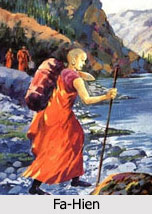 Fa-Hien who is also known as Faxian, was a Chinese pilgrim who came to India from China to learn Buddhism and to preach Buddhism to Central Asia. He is also known as a Buddhist monk. His journey is described in his important travelogue, "A Record of Buddhist Kingdoms, Being an Account by the Chinese Monk Fa-Xian of his Travels in India and Ceylon in Search of the Buddhist Books of Discipline".
Fa-Hien who is also known as Faxian, was a Chinese pilgrim who came to India from China to learn Buddhism and to preach Buddhism to Central Asia. He is also known as a Buddhist monk. His journey is described in his important travelogue, "A Record of Buddhist Kingdoms, Being an Account by the Chinese Monk Fa-Xian of his Travels in India and Ceylon in Search of the Buddhist Books of Discipline".
Travelling from China to India
Fa-Hien visited Central Asia, India, and Sri Lanka and left accounts of his travels. He travelled to different places to acquire Buddhist Scriptures. A native of Shanxi (Shansi), Fa-Hien left home at the tender age of three to join the Buddhist Sangha. After his novitiate, Fa-Hien wished to go to India to search for the treatises of the Vinaya Pitaka, the monastic rules of Buddhism.
Account of Fa Hien
Fa-Hien travelled India during the reign of Chandragupta II. Here Fa-Hien spent 6 years in studies. For three years he stayed in the imperial city of Pataliputra, where he learnt Sanskrit. He was impressed to see Asoka`s palace. Near that palace stood the two imposing monasteries where the Hinayana and the Mahayana monks were busy in the exposition of the Buddhist Law of Piety. These monasteries attracted seekers of all knowledge from different parts of the country.
Places visited by Fa Hien
Fa-Hein visited the holy Buddhist sites located in the Ganges valley. He visited Kapilavastu which is the birthplace of Lord Buddha; Bodhgaya, the site of Buddha`s enlightenment; Sarnath, where Buddha preached his first sermon, and Kushinagara, the place of Buddha`s Nirvana.
Political and Social Account of Fa-Hien
Fa-Hien was much impressed with the wealth and progress of Magadha. The Magadhans vied with each other in the practice of benevolence and righteousness. The Buddhist procession annually paraded the city and that was a splendid scene. Pataliputra had excellent hospital where patients from all parts of country came. They were supplied with food and medicine and sufficient care was taken. People emulated each other in the practice of virtue. The principle of Ahimsa was still dominant. There was no wine-shop in the market place. People were vegetarian. They did not take pigs, fowls, onions and garlics nor drank wine. The social outcastes were called chandals. The king made grants to monasteries. Brahmanism was predominant in the erstwhile Madhya Pradesh and the king himself was a devout Vaishnava. The relation between the Brahmanis and Buddhists was cordial. The religious persecution was absent. The people enjoyed the blessings of peace. The liberty of conscience was assured. Gaya was desolate and empty and Kapilavastu and Kusinagara were also decaying. Only two hundred families occupied Sravasti. Roads were safe for the travelers.
Religious Account of Fa Hien
According to Fa-Hien, it was at Vaishali that Gautama Buddha, having given up the idea of living longer said to Ananda-"In three months from this I will attain to Parinirvan and Mara had so fascinated and stupefied Ananda that he was not able to ask Buddha to remain longer in this world".
Books by Fa Hien
Fa-Hien wrote a book on his travels, filled with accounts of early Buddhism in India and Central Asia, and the geography and history of numerous countries along the Silk Roads as they were, at the turn of the 5th century BC along with the social, political and religious scenario of Chandra Gupta Vikramaditya regime.



















